There are few topics in the world of guitar theory which seem to cause as much confusion as modes. I speak partly from personal experience here.
When I first wanted to move beyond playing the minor and major pentatonic and blues scales, I tried to teach myself the modes. For a long time, I had little success. And looking back, I am not surprised that this was the case.
The language used to explain the modes on your guitar is complicated. Not only this, but properly using and understanding the modes requires a little more theoretical knowledge.
You can get great results soloing and improvising with the minor pentatonic scale, even if you don’t really understand how it works. The same is not quite true of the modes. As such, if you are starting from scratch on the theory front, I would strongly recommend reading the following articles before continuing here:
I know that you want to get to grips with guitar modes as soon as possible. But please learn from my mistakes. Trying to learn the modes without understanding how they function is very challenging. And it will give you hit and miss results at best.
So even though it might feel like you are spending a lot of time working through the theory – it is worth it. You will be able to use the modes on your guitar much more effectively. In fact I would argue that this approach will actually save you time in the long run too.
Assuming then that you are comfortable with the concepts outlined in the articles linked above, let’s turn our attention to the modes. In this article I will cover everything you need to get started using the modes on your guitar.
So with that in mind, let’s get into it! Here is an introduction to playing the modes on your guitar:
The major scale
Before we look at the modes on your guitar, we need to return to the major scale. This is of fundamental importance, because as I will explain in much more detail throughout – the major scale is the ‘parent scale’ from which all of the modes are derived.
As such, if you want to play the modes on your guitar, you first need to be able to play the major scale all over your fretboard. Not only this, but you need to understand how the major scale is structured and which intervals appear in the scale.
So let’s run through a quick recap:
The major scale is a heptatonic scale. This is because it is comprised of 7 notes per octave, (‘hepta’ meaning 7 in Greek). The scale ‘formula’ for the major scale is as follows:
1 2 3 4 5 6 7
Each of the numbers above represents an interval that appears in the scale. And in the major scale, all of the intervals are either major or perfect. In the key of A, the notes of the major scale are as follows:
A B C♯ D E F♯ G♯
Each of the numbers 1-7 corresponds to one of the notes above. A is 1, B is 2 and so on. This is what the A major scale looks like when played horizontally across the 6th string on your guitar:
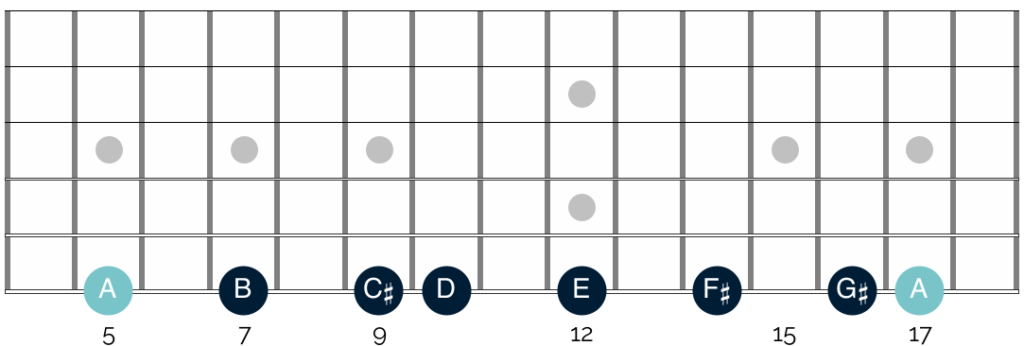
When laid out visually in this way, you can see that the major scale is constructed in a series of alternating tones and semitones (or half steps and whole steps). Specifically, the spacings on the fretboard are as follows:
Whole step | Whole step | Half step | Whole step | Whole step | Whole step | Half step
A lot of guitarists find it helpful to repeat this series of spaces when they first learn the scale. And it certainly can be a useful mechanism for remembering the pattern of notes, which has a different sound and feel to many of the scales with which you might be familiar.
As a reminder, here is what the 5 shapes of the A major scale look like when laid out on your fretboard:
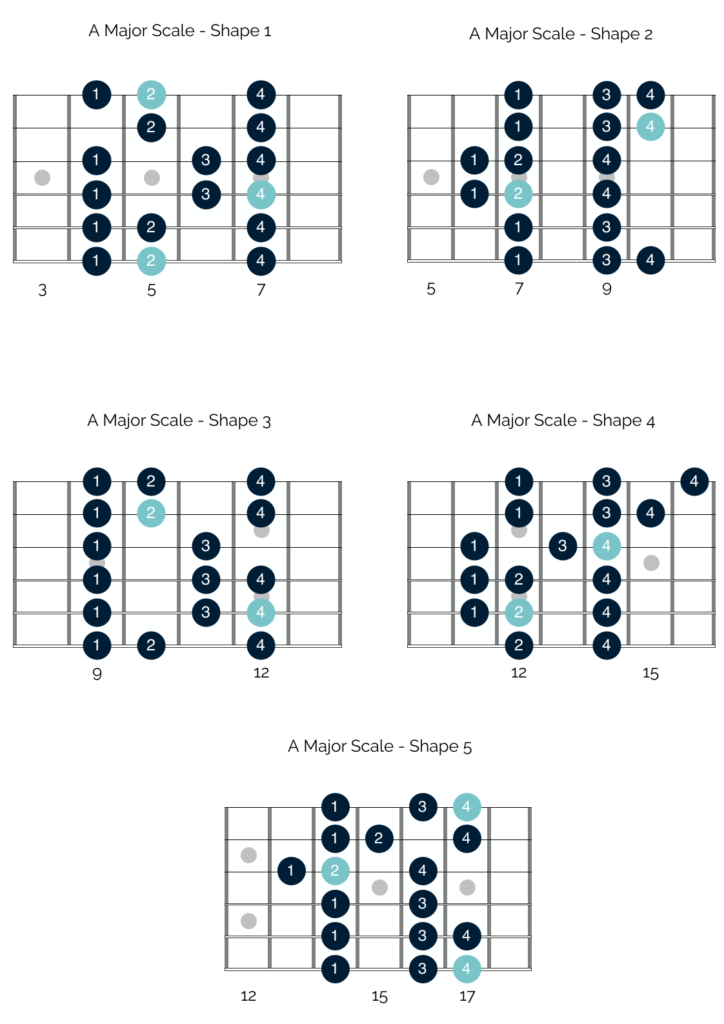
As I noted in more detail here, there are different fingerings that you can use to play these scales. However the fingerings included above are those which I think work best for most blues and blues rock guitarists. The notes highlighted in light blue are the tonic notes, which in this example are the notes of A.
Now, unlike some of the other guitar scales with which you might be familiar, it is more challenging to use the major scale in your guitar playing straight away.
And in fact, if you are predominantly interested in playing blues and blues rock music, it is unlikely that you will use the major scale in your playing with much frequency. Instead it is much more likely that you will use the modes.
What are the modes?
The modes are a series of scales that are built from the major scale. They contain all of the same notes as the major scale. The key difference is that each mode starts on a different note of the major scale.
This has a significant impact on the intervals between the notes in the scale. And this changes the sound and character of each of the modal scales. This is true – even though the notes in each of these modal scales are the same.
This is the key idea you need to understand when learning the modes. As such, it is one that I will cover in much more detail below. However we can run through a quick example here to help bring the idea to life before digging into it in more detail. To do this, let’s return to the major scale:

This diagram shows the notes and intervals of the A major scale. When we start on the note of A and play through the major scale, we end up with the intervals shown above.
Now, if we keep everything here the same, but just change the starting note of the scale to be B, rather than A, you will see that all of the intervals between the notes change:

As you can see, the actual notes included in this second diagram are exactly the same as those in the diagram showing the A major scale. The only difference is that now, the root note of the scale is B, instead of A. This seemingly small change has a knock on effect on the rest of the scale. It alters the intervals between the notes, and this fundamentally changes how the scale sounds and functions.
This concept will become clearer as we look at the specific modes in further detail below. However I hope this helps you to appreciate this idea, as it is key to understanding how the modes function on your guitar.
For now though, let’s look at some of the broader facts about the modes before we dig into them in greater detail.
The fundamentals of the modes
There are 7 modes on your guitar. And each of these is built from one of the 7 notes of the major scale. So there is a mode built from the second note of the major scale, as well as the third note and fourth note etc.
Part of what makes it challenging to understand the modes at first is that they all have Greek names. The names of the modes and the order in which they appear is as follows:
| Ionian | Dorian | Phrygian | Lydian | Mixolydian | Aeolian | Locrian |
Thankfully, there are a few easy mnemonics to help you remember the names and order of the modes. Two of my favourites of these are as follows:
- I Don’t Particularly Like Modes A Lot
- I Don’t Particularly Like My Aunt Lucy
You don’t need to worry about memorising the order of the modes right away. However it is useful to begin using the names of the modes as early as possible.
This will help you to become more comfortable with the language that is used to discuss them. It will also remove some of the initial confusion which can stem from their unusual names.
For now though, let’s turn our attention to the construction of the modes. This will help you to understand how each mode is structured, the different characteristics of each of the modes, and how you can actually play the modes on your guitar.
Modal construction
As noted above, each of the 7 modes is built from a note of the major scale. The Ionian mode is based off the first note. Dorian is based off the second note, Phrygian from the third, and so on.
If we start with the A major scale then, the modes run as follows:
| A Ionian | B Dorian | C# Phrygian | D Lydian | E Mixolydian | F# Aeolian | G# Locrian |
Each of the modal scales is built off a new note and as such, the scale relates back to that starting note.
So even though we start with the A major scale and we technically continue to play the notes of the A major scale (even as we work through the modal scales), we don’t end up with A Dorian and A Phrygian etc. Instead we end up with B Dorian and C# Phrygian.
It is important to understand this point, as it will help you to understand how the modal scales fit together, and how you can navigate and use the modes in your guitar playing.
It is worth noting that this idea applies across all keys. In the key of C major for example, the notes of the scale are as follows:
C D E F G A B
So when you create modal scales from the notes of C major, you end up with a totally different list of scales to those in A major. Here you end up with D Dorian, E Phrygian, F Lydian and so on. And if you were to start this process in E major or G major, the results would be different again.
I appreciate that at this stage, this is likely to sound quite confusing. Don’t worry though, you don’t need to get to grips with everything straight away.
For now, the key idea to take away is that in any major key, the Ionian mode is built from the first note, Dorian from the second, Phrygian from the third, and so on.
Modes and chords
The final piece of the puzzle that we need to cover before looking at each of the individual modes in more detail, is chord construction. As I covered in much more detail in this article here, if you harmonise the notes of the major scale and turn them into triads, you end up with the following series of chords:
| Major | Minor | Minor | Major | Major | Minor | Diminished |
In the key of A major, going through this process will give you the following chords:
| A major | B minor | C# minor | D major | E major | F# minor | G# diminished |
So in the same way that each of the modes is based off the note of A, B and C# etc, the same is true of the chords listed above. The ‘I’ chord in the B Dorian mode is B minor. In C# Phrygian it is C# minor. And so on.
I will explain in much more detail why it is important to appreciate this point. For now though, it is just worth keeping this in mind.
Now with that covered, let’s dig into each of the individual modes in a bit more detail. This will help you to understand how each mode is constructed, and how each of the modes sounds.
Ionian mode
The first mode is nice and easy to understand. This is because the Ionian mode is in fact the same as the major scale.
The two scales are exactly the same and so the terms are used interchangeably. In fact, the Ionian mode is much more commonly referred to as the major scale. As a result, it is quite unusual for guitarists to refer to the Ionian mode.
The Ionian mode is a major mode. It sounds upbeat, bright and happy. It also has a somewhat triumphant and grandiose sound. For this reason, it has been used a lot in classical music and film scores (examples of this are included below). Here are the key pieces of information you need to know about the Ionian mode:
| Scale Formula | 1 2 3 4 5 6 7 |
| Notes in A Ionian | A B C# D E F# G# |
| Chords | A major, B minor, C# minor , D major, E major, F# minor, G# diminished |
This is what the first shape of the Ionian mode looks like in the key of A. The notes in light blue are the tonic notes, which here are the notes of A:
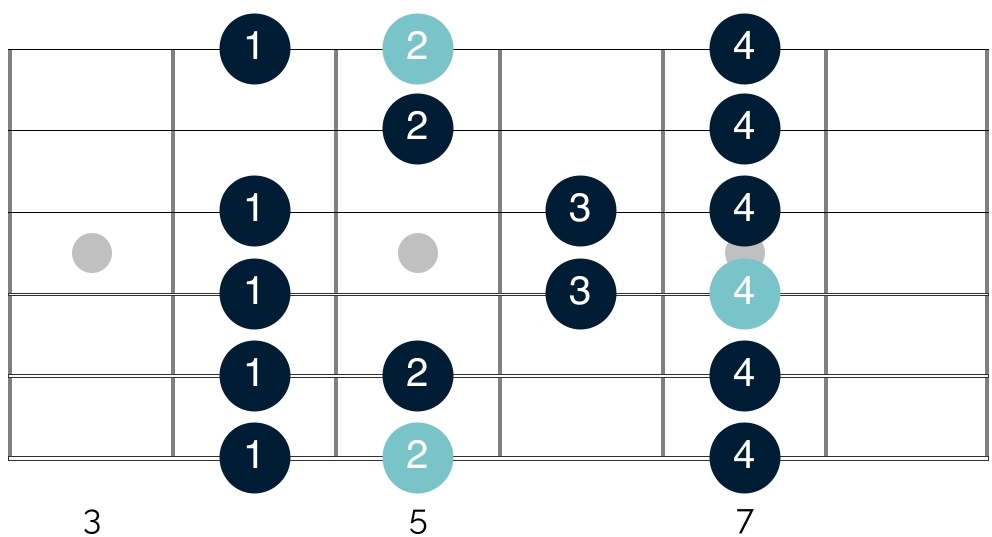
As a result of its upbeat and bright sound, the Ionian mode tends not to be used a lot in blues or rock music. Having said that, there are a range of songs that make use of this mode. Just some of these are as follows:
- ‘Cliffs Of Dover‘ – Eric Johnson
- ‘Twist & Shout‘ – The Beatles
- ‘Lean On Me‘ – Bill Withers
- ‘Love Thing‘ – Joe Satriani
It is still more common however for the Ionian mode to be used in classical music. If you want to hear the triumphant sound of the mode in full force, just listen to pieces like ‘Raider’s March‘ or ‘Superman March‘ – both by composer John Williams.
Dorian mode
The second mode of the major scale is the Dorian mode. Unlike the Ionian mode, the Dorian mode is a minor mode. As such, it has a more downbeat sound when compared with the Ionian mode. Having said that, compared with some of the other minor modes, the Dorian mode is not a very melancholy or dark sounding mode.
In fact it has quite a laid back and relaxed feel, which makes it one of the most commonly used modes. Here are the key pieces of information you need to know about the Dorian mode:
| Scale Formula | 1 2 b3 4 5 6 b7 |
| Notes in B Dorian | B C# D E F# G# A |
| Chords | B minor, C# minor, D major, E major, F# minor, G# diminished, A major |
This is what the first shape of the Dorian mode looks like on your guitar. The notes in light blue are the tonic notes, which here are the notes of B:
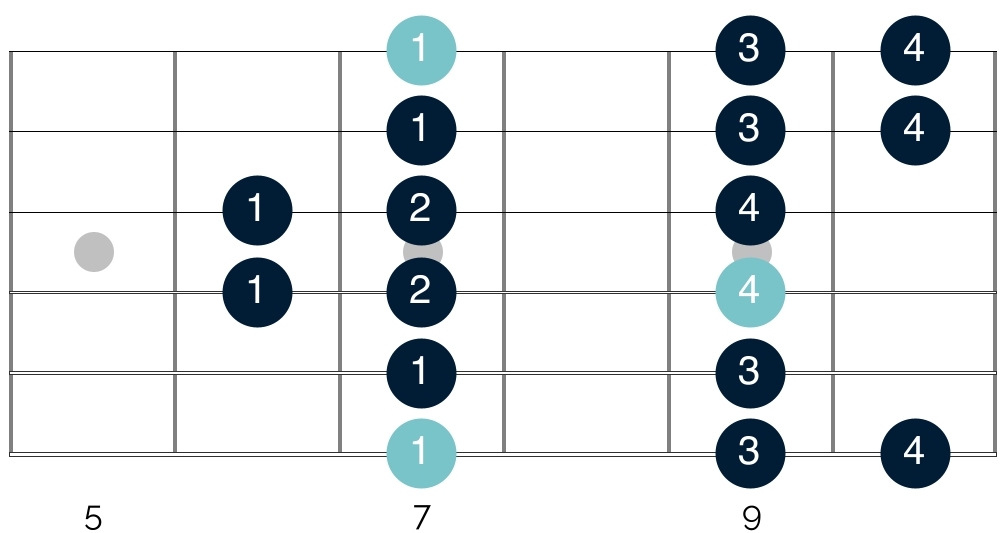
The sound of the Dorian mode is quite different to the Ionian mode. Even though the notes of the scale are the same, the relationship between the notes have all changed.
This is because the tonic note here is the note of B, not A (as it was above). This changes the intervals between the notes in the scale. As such, there is now a b3 interval (which makes the mode minor) and also a b7.
These two intervals create that minor sound. Yet the remaining intervals are the same as in the Ionian mode. This prevents the Dorian mode from sounding very dark and intensely minor.
And it is for this reason that Dorian is so widely used. It appears perhaps most frequently in funk, with just some notable examples of songs that use the Dorian mode including:
- ‘I Wish‘ – Stevie Wonder
- ‘Get Lucky‘ – Daft Punk
- ‘Pick Up The Pieces‘ – Average White Band
- ‘Good Times‘ – CHIC
The Dorian mode isn’t just limited to funk however. It can sound amazing in a blues and blues rock context, and in my opinion it is one of the most useful modes if you want to add a slightly different ‘flavour’ to your improvisations.
Carlos Santana uses the Dorian mode a lot in his solos. ‘Evil Ways‘ and ‘Oye Como Va‘ are just two notable examples of songs which are based on the Dorian mode. David Gilmour also uses the Dorian mode to great effect. The iconic song ‘Another Brick In The Wall Pt. II‘ is based around the Dorian mode.
Phrygian mode
Like the Dorian mode, Phrygian is also a minor mode. However compared with Dorian it has a much heavier and darker sound. Here are the key pieces of information you need to know about the Phrygian mode:
| Scale Formula | 1 b2 b3 4 5 b6 b7 |
| Notes in C# Phyrgian | C# D E F# G# A B |
| Chords | C# minor, D major, E major, F# minor, G# diminished, A major, B minor |
This is what the first shape of the Phrygian mode looks like on your guitar:
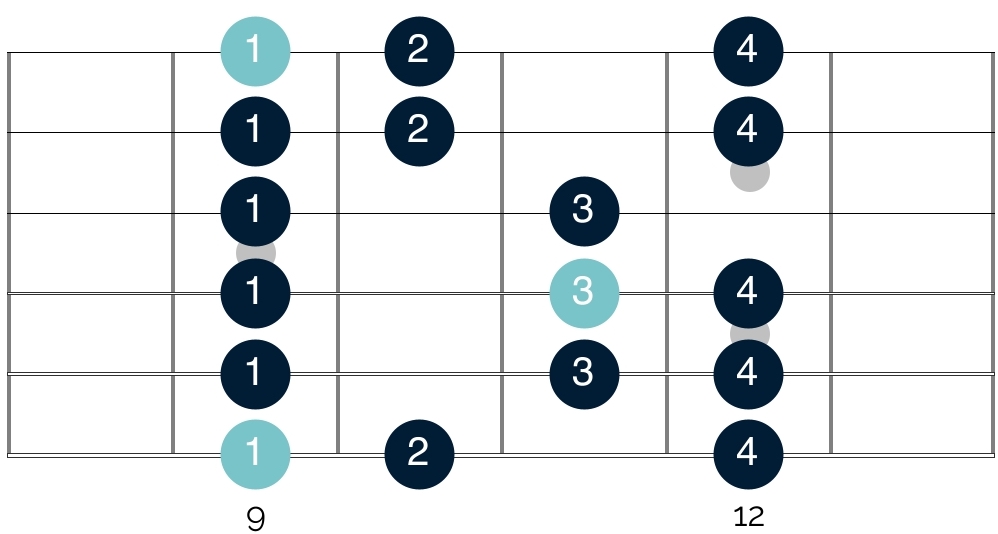
The Phrygian mode has a more intense and ‘heavy’ feel than Dorian. Largely because of this, it is not really used in the blues at all (I can’t recall any blues or blues rock songs that make use of this mode in any significant way).
Instead it appears with much greater frequency in heavy metal music. Some notable songs that use the Phrygian mode are as follows:
- ‘Wherever I May Roam‘ – Metallica
- ‘Symphony Of Destruction‘ – Megadeth
- ‘War‘ – Joe Satriani
The b2 interval that is present in the Phyrgian mode also gives this mode somewhat of an exotic feel. This sound doesn’t fit particularly well in a blues context, but can sound very effective depending on the type of music you are trying to create.
Lydian
Like Ionian, the Lydian mode is a major mode. And in fact, its scale formula is almost identical to that of the Ionian mode. Here are the key pieces of information you need to know about the Lydian mode:
| Scale Formula | 1 2 3 #4 5 6 7 |
| Notes in D Lydian | D E F# G# A B C# |
| Chords | D major, E major, F# minor, G# diminished, A major, B minor, C# minor |
The only difference between the Ionian and Lydian modes is that in the Lydian mode, there is a #4. Yet whilst there is just a single note of difference between the scales, their characteristics are quite different.
Like Ionian, Lydian has a happy and upbeat tonality. In contrast to Ionian however, the triumphant and grandiose feel is replaced by one that is somewhat mystical and ethereal.
This is what the first shape of the Lydian mode looks like on your guitar:
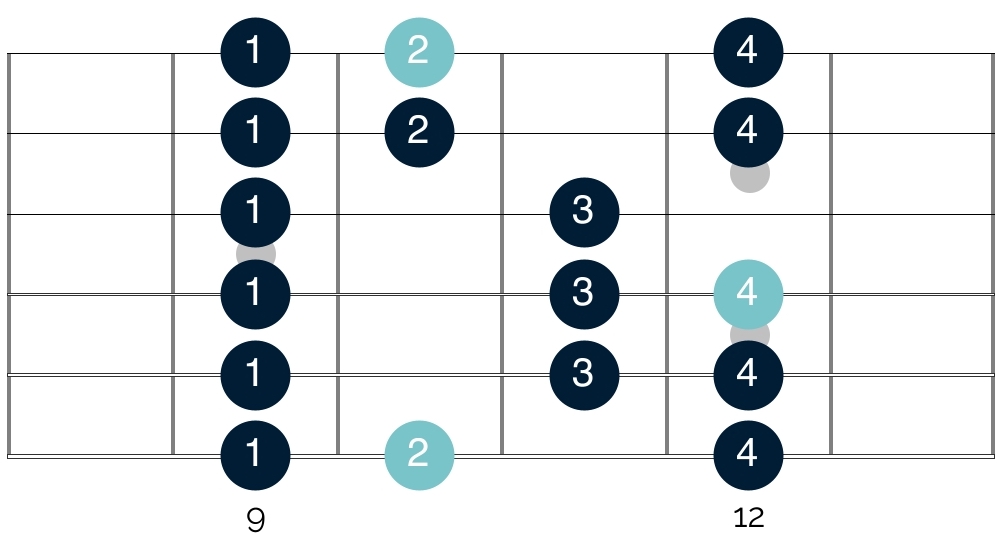
The #4 interval is what gives Lydian its distinctive feel. And so musicians focus in on this interval to create an ‘other worldly’ sound in their compositions. Some notable songs that use the Lydian mode are as follows:
- ‘Man On The Moon‘ – R.E.M.
- ‘Flying In A Blue Dream‘ – Joe Satriani
- ‘Space Oddity‘ – David Bowie
This other worldly sound – whilst beautiful and interesting – is not particularly well suited to blues or blues rock music. So if you are interested in these styles of music, it is unlikely that you will encounter the Lydian mode with much frequency.
Mixolydian mode
Like the Lydian mode, the Mixolydian mode is also a major mode. Also like the Lydian mode, there is just a single note that separates the Mixolydian mode from the Ionian. Here are the key pieces of information you need to know about the Mixolydian mode:
| Scale Formula | 1 2 3 4 5 6 b7 |
| Notes in E Mixolydian | E F# G# A B C# D |
| Chords | E major, F# minor, G# diminished, A major, B minor, C# minor, D major |
The only difference here is that in the Mixolydian mode there is a b7. As with the Lydian mode, this single note changes the feel and character of the mode.
And here the b7 takes away some of the happiness and brightness of the Ionian mode. This makes it sound a little more tense and bluesy – which makes it a brilliant choice for blues and rock guitarists.
This is what the first shape of the Mixolydian mode looks like on your guitar:
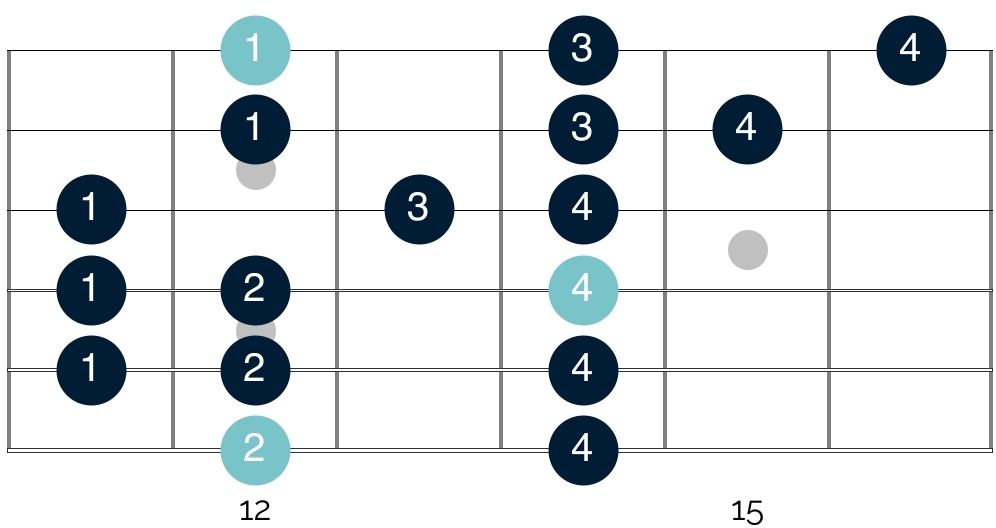
You can view this mode as somewhat of a blend between the major scale and the blues scale. It makes a brilliant choice for soloing and improvising in a major blues context. And it is a great way to add complexity and depth to your blues playing. Some notable songs that use the Mixolydian mode are as follows:
- ‘Highway To Hell‘ – AC/DC
- ‘Jessica‘ – The Allman Brothers Band
- ‘All Right Now‘ – Free
- ‘Third Stone From The Sun‘ – Jimi Hendrix
- ‘I’m So Glad‘ – Cream
As you can see – the sound of the Mixolydian mode is perfect if you want to create an upbeat blues or blues rock sound. In fact, AC/DC use the Mixolydian mode in so many of their songs that it has somewhat come to define their sound.
Aeolian mode
The Aeolian mode – also referred to as the natural minor or relative minor scale – is a minor mode. It has a sound and feel that sits somewhere between Dorian and Phrygian. It is more melancholic and downbeat than Dorian, with a little more bite and aggression.
However it isn’t quite as intense or dark as Phrygian. Here are the key pieces of information you need to know about the Aeolian mode:
| Scale Formula | 1 2 b3 4 5 b6 b7 |
| Notes in F# Aeolian | F# G# A B C# D E |
| Chords | F# minor, G# diminished, A major, B minor, C# minor, D major, E major |
This is what the first shape of the Aeolian mode looks like on your guitar:
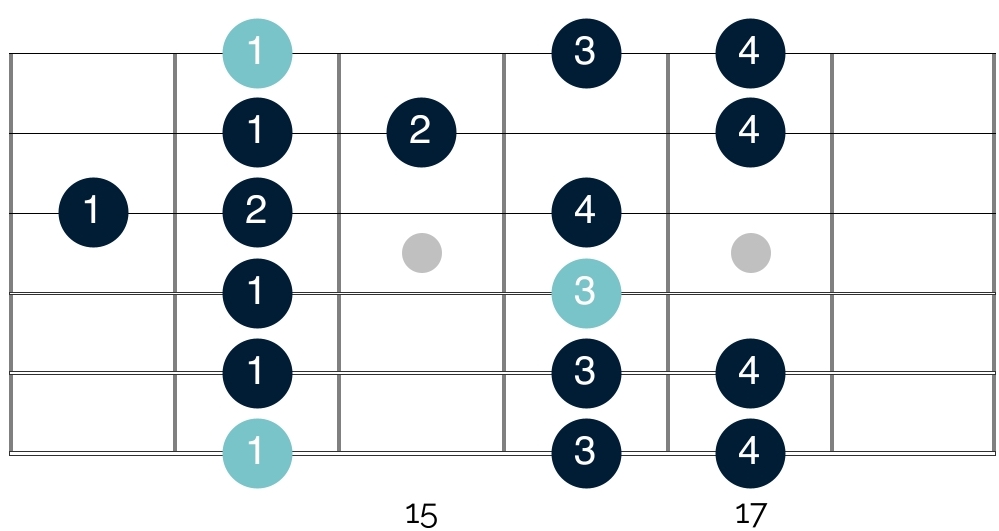
Like the Mixolydian mode, the Aeolian mode is widely used in blues and blues rock music. As such, it is one that you are likely to encounter quite a lot in this style.
And in fact, as I will explain in more detail in future articles, this mode can help to add depth and colour to your blues improvisations in a minor blues context. Some notable songs that use the Aeolian mode are as follows:
- ‘The Thrill Is Gone‘ – B.B. King
- ‘Still Got The Blues‘ – Gary Moore
- ‘All Along The Watchtower‘ – Jimi Hendrix
- ‘Black Magic Woman‘ – Fleetwood Mac
In the same way that the Mixolydian mode works very well when you are playing in a major blues context, the Aeolian mode is a brilliant choice when you are soloing over a minor blues progression.
Locrian mode
The final mode is one that is largely theoretical. In fact most composers and musicians dismiss this mode when it comes to writing and performing music. This is because it has such a tense and unsettled sound.
Like the Dorian, Phyrgian and Aeolian modes, Locrian is a minor mode. The key difference however is that the tonic chord on which the Locrian mode is based is diminished.
Diminished chords have a dissonant sound. And as such, the Locrian mode as a whole is quite jarring. Here are the key pieces of information you need to know about the Locrian mode:
| Scale Formula | 1 b2 b3 4 b5 b6 b7 |
| Notes in G# Locrian | G# A B C# D E F# |
| Chords | G# diminished, A major, B minor, C# minor, D major, E major, F# minor |
This is what the first shape of the Locrian mode looks like on your guitar:

To find songs that are truly based on the Locrian mode is challenging. The diminished chord on which the mode is centred does not sound resolved.
As such, those moments of resolution we look for (and need) in music never really occurs. You never have that satisfying moment of resolution, and this has resulted in very few songs using the mode. Just a few examples that I have been able to find are as follows:
- ‘Army Of Me‘ – Björk
- ‘Combustion‘ – Meshuggah
- ‘Wisdom Comes‘ – Gojira
In contrast to some of the other songs listed throughout, these songs feature elements of the Locrian mode. They are not purely based around the mode (as is the case with some of the other songs listed here), for the reasons I have noted earlier.
Either way though, unless you are interested in creating intensely dissonant styles of music, the Locrian mode is one that you are almost never going to encounter. I have just included it here for completeness and so you have a thorough understanding of all of the modes on your guitar.
Modal scale shapes – Pt I
At this stage, I hope that you feel more confident with some of the theory behind the modes. I also hope that you can appreciate the sound and character of each mode. However this information doesn’t yet help you to play the modes on your guitar.
The brilliant news though is that you don’t need to learn any new scale shapes to play the modes.
The scale shapes of the major scale (Ionian mode) are exactly the same as those you need to play all of the 6 remaining modes. You can see this if you compare the scale diagrams for the major scale (linked at the beginning of this article) with the individual scale shapes shown for each of the modes.
Upon a little further inspection, I hope you can see that there are no new scale shapes introduced in any of the modes.
In fact, you may already have spotted some of the relationships between the modal scale shapes, which will help you to start playing the modes on your guitar. If not, then don’t worry – we’re going to run through this now in much more detail.
The relationship between the modal scales is as follows:
The Dorian mode – which is the second mode of the major scale – starts with the second shape of the major scale. So when you are playing the Dorian mode, you use all of the same scale shapes as when you use the major scale.
Now though everything is moved along one degree. So what was shape 3 in the major scale is now shape 2 in the Dorian mode. What was shape 4 in the major scale is now shape 3 in the Dorian mode, and so on.
As is typically the case with scale shapes on your guitar, when you reach shape 5, you simply move on to shape 1. So in the Dorian mode, you start on shape 2 of the major scale, and then play shapes 3, 4, 5 and 1.
Similarly, the Phrygian mode – which is the third mode of the major scale – starts with the third scale shape of the major scale. Again, you have all of the same scale shapes as when you use the major scale. Now though everything is moved along two degrees.
So what was shape 4 in the major scale is now shape 2 in the Phrygian mode. What was shape 5 in the major scale is now shape 3 in the Phrygian mode, and so on.
As with the Dorian mode, when you reach shape 5 of the major scale in Phrygian, you move back to shape 1. So in the Phrygian mode you start on shape 3 of the major scale, and then play shapes 4, 5, 1 and 2.
Modal scale shapes – Pt II
Now, because there are only 5 shapes of the major scale (at least when you use closed grip fingerings) but there are 7 modes, you can’t continue to follow this process through all of the modes.
For example, if you were to follow this logic, by the time you reach the 6th mode, you’d be back at the first shape of the major scale.
As a result, there are 2 points where this pattern diverges slightly.
The first of these is with the Lydian mode. The scale shapes and the order of the scale shapes in the Lydian mode are exactly the same as in the Phrygian mode. The key difference is that these scale shapes start on different tonic notes. Let’s look at this with the first shape of both scales:
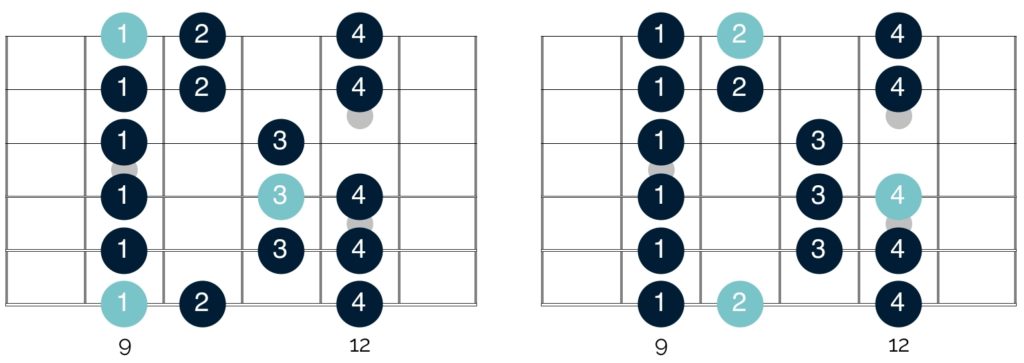
The diagram on the left shows the Phrygian mode, whilst the one on the right shows the Lydian mode. As you can see, the scale shapes and the position where you play them on the neck are identical. The only difference is that the root note in the Phrygian mode is C#. For the Lydian mode it is D.
The same relationship exists between the Ionian and Locrian modes. The scale shapes and the order of the scale shapes are exactly the same in both of these modes on your guitar. The key difference is that these scale shapes start on different tonic notes. Let’s look at this with the first shape of both scales:
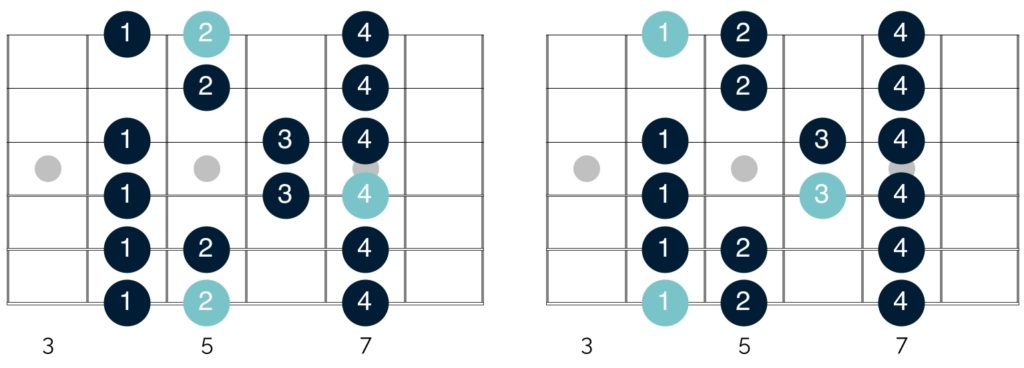
The diagram on the left shows the Ionian mode, whilst the one on the right shows the Locrian mode. Again, as you can see, the scale shapes and the position where you play them on the neck are identical. The only difference is that the root note in the Ionian mode is A. For the Locrian mode it is G#.
Modes in context
Changing the root note in this way only makes a difference in a proper musical context.
For example, if you play the different scale shapes from the diagrams above one after another – Phyrgian and Lydian will sound identical. And the same will be true for Ionian and Locrian.
They only sound different when they are placed in a proper musical context. This is true for all of the modes. And it is one of the key points you need to understand if you want to use the modes in your guitar playing.
The sound of each mode is evident when you play it in its intended musical context. If for example you want to create the sound of B Dorian, you have to play the Dorian scale shapes over a B minor chord. If you want to create the sound of C# Phrygian, you have to play the Phrygian scale shapes over a C# minor chord.
The notes of B Dorian and A Ionian are the same. And this is true of C# Phrygian, D Lydian and E Mixolydian etc. Each scale shape can produce a variety of different sounds and feels. The key to creating a particular sound in your playing is to ensure you know the chords and musical context you are playing over.
How to use the modes in your guitar playing
At this stage then, you might be wondering how you can actually use the modes in your guitar playing.
To cover this topic in depth is beyond the scope of this article. It is very lengthy and as such it is one that I will cover in much more detail in future. I will also go into more granular detail on modes like Dorian, Mixolydian and Aeolian – as these are the modes that you are more likely to use when playing blues and blues rock music.
Here though, I will cover some of the fundamental points that will help you to get started using the modes in your guitar playing.
To do this, let’s recap all of the modes and their characteristics:
| Mode | Ionian | Dorian | Phrygian | Lydian | Mixolydian | Aeolian | Locrian |
| Scale Formula | 1 2 3 4 5 6 7 | 1 2 b3 4 5 6 b7 | 1 b2 b3 4 5 b6 b7 | 1 2 3 #4 5 6 7 | 1 2 3 4 5 6 b7 | 1 2 b3 4 5 b6 b7 | 1 b2 b3 4 b5 b6 b7 |
| Notes in A major | A B C# D E F# G# | B C# D E F# G# A | C# D E F# G# A B | D E F# G# A B C# | E F# G# A B C# D | F# G# A B C# D E | G# A B C# D E F# |
| Chords | A, Bm, C#m, D, E, F#m, G#mb5 | Bm, C#m, D, E, F#m, G#mb5, A | C#m, D, E, F#m, G#mb5, A, Bm | D, E, F#m, G#mb5, A, Bm, C#m | E, F#m, G#mb5, A, Bm, C#m, D | F#m, G#mb5, A, Bm, C#m, D, E | G#mb5, A, Bm, C#m, D, E, F#m |
| Tonality | Major | Minor | Minor | Major | Major | Minor | Minor/ Diminished |
Now, using this table, we can look at how to use the modes on the guitar – both when soloing and also playing rhythm.
Soloing with the modes
If you want to get started improvising using the modes, then all you need to do is check the key you are playing in, and the tonality of that key. You can then decide which mode you want to play.
For example, if you are playing in a minor key, you have the choice of 3 different minor modes – Dorian, Phrygian and Aeolian.
Conversely, if you are playing in a major key, you have the choice of 3 different major modes – Ionian, Lydian and Mixolydian.
As noted earlier – the Locrian mode is predominantly a theoretical mode and isn’t one that you will really use in a playing context.
The mode you choose to use will depend on the feel you want to create in your playing. It will also be somewhat determined by the chords you are soloing over. This is quite a complex point and as such is beyond the scope of this article.
For now then, all you need to be sure of is that the modal scale you choose corresponds with the chord over which you are playing. For example, you would play D Lydian over a D major chord (or a similar major type chord). If you wanted to play C# Phrygian, you would play that over a C# minor chord (or a similar minor type chord).
It is also important to note that you can move these ideas beyond the A major scale.
Let’s say for example that you want to play in D Dorian. All you need to do is move your modal scale shapes to reflect the change in key. For example, the first scale shape of Dorian in the key of D would look like this on your fretboard:
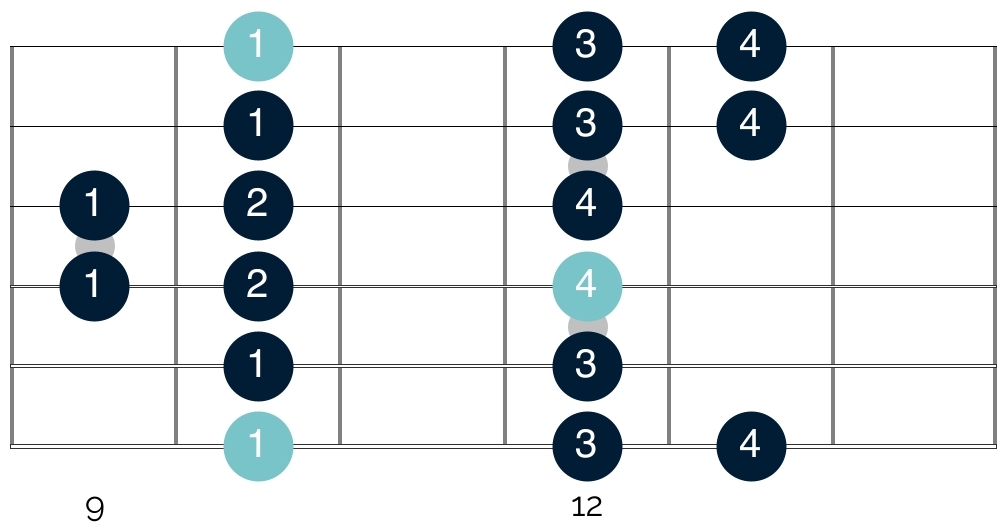
As you can see, the scale shape for D Dorian is the same as for B Dorian. The only difference is the starting note for the scales. This same idea applies to all of the modes. All you need to do is take the first scale shape and then move it to a new part of your fretboard.
Playing chords with the modes
As noted above, when you harmonise the major scale and turn it into chords, you end up with 7 different chords. Musicians use these chords to create chord progressions. And they refer to the chords using Roman numerals.
So in the key of A major, the chord of A major is expressed as I. The chord of B minor is expressed as ii, and so on. Upper case numerals are used for major chords, and lower case numerals are used for minor chords.
The diminished chord is also represented by a lower case numeral. In this case however, it is either preceded or followed by a small circular symbol to distinguish it as being diminished.
Just as the notes of the various modal scales change as you move through them, the same is true for the chords.
In A major for example, the I chord is A major. The ii chord is B minor and the iii chord is C# minor. However in B Dorian, the first chord is now B minor. So B minor is the i chord, C# minor is the ii chord, and D major is the III chord.
In the A Ionian mode then, the I, ii and iii chords are A major, B minor and C# minor
In the B Dorian mode they are now B minor, C# minor and D major.
The same thing happens as you cycle through the modes. We can see this when we compare all of the chords in the different modes together:
| Mode | Ionian | Dorian | Phrygian | Lydian | Mixolydian | Aeolian | Locrian |
| Notes in A major | A B C# D E F# G# | B C# D E F# G# A | C# D E F# G# A B | D E F# G# A B C# | E F# G# A B C# D | F# G# A B C# D E | G# A B C# D E F# |
| Chords | A, Bm, C#m, D, E, F#m, G#mb5 | Bm, C#m, D, E, F#m, G#mb5, A | C#m, D, E, F#m, G#mb5, A, Bm | D, E, F#m, G#mb5, A, Bm, C#m | E, F#m, G#mb5, A, Bm, C#m, D | F#m, G#mb5, A, Bm, C#m, D, E | G#mb5, A, Bm, C#m, D, E, F#m |
| Chord Numbers | I, ii, iii, IV, V, vi, vii° | i, ii, III, IV, v, vi°, VII | i, II, III, iv, v°, VI, vii | I, II, iii, iv°, V, vi, vii | I, ii, iii°, IV, v, vi, VII | i, ii°, III, iv, v, VI, VII | i°, II, iii, iv, V, VI, vii |
Don’t worry about getting to grips with everything in this table. You don’t need to learn the specific chords which appear when you harmonise these scales. The important point to work to understand is how the chord progressions change as you cycle through the different modes.
Putting it all together
Well there we have it, the fundamentals of the modes and how you can apply them to your guitar.
If you are totally new to this material, then don’t feel the pressure to get to grips with it all in one go. Understanding modes and how you use them in your guitar playing is not easy. In fact for most guitarists it represents their first major departure away from pentatonic scales, which require less understanding of theory.
As such, work through this material nice and slowly. In my experience, understanding and successfully using the modes requires you to slot various different pieces of music theory together. If one piece is missing, then it can make it difficult for you to appreciate the whole picture.
So, don’t rush through the material here. It is much better for you to take a little longer getting to grips with these concepts – but to really understand and feel comfortable with them – than it is to rush through them and fail to piece everything together.
This is particularly the case here, as the information included in this article is intended to serve as an introduction to modes on your guitar.
As is always the case when it comes to the guitar, you can go much deeper on this topic. And in future articles I will cover the modes and how to use them practically in more detail.
If you want to understand that material and to use these modes confidently in your playing though, then it is first important for you to have a solid grasp of these concepts. This will ensure you continue to step on and improve and can do so without any gaps in your knowledge.
Good luck! Let me know how you get on, and if you have any questions at all please do get in touch. Drop a note in the comments section, or send me an email on aidan@happybluesman.com. I’d love to help 😁
References & Images
Unsplash, YouTube, Registry Of Guitar Tutors, YouTube, Ultimate Guitar, YouTube, Guitar World, Wikipedia, YouTube, Premier Guitar, Guitar Theory For Dummies, YouTube, Music Stack Exchange, YouTube, YouTube, Guitar Lesson World, The Practical Guide To Modern Music Theory For Guitarists





Responses
Very interesting article , Aidan!!
Thank you very much for sharing your knowledge with all of us in such a simple and didactic way. I really appreciate it!
Greetings from Barcelona.
Thank you so much for taking the time to write such a kind comment Albert, it really means a lot. I am very glad to hear that you have found the website helpful. And if I can help in any further way with your playing or if you have any more questions, just send them over. You can reach me on aidan@happybluesman.com and I am always around and happy to help 😁
hepta is Greek not Latin
Thank you so much for spotting the type GG – I’ve just updated it now 😁